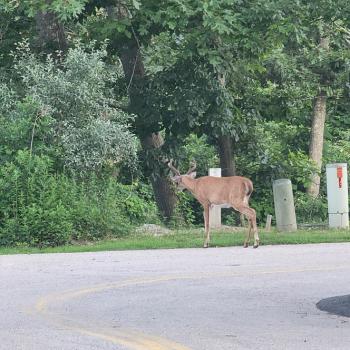Although I am mercilessly critical of New Englanders who complain about snow and cold weather, as if they just became aware that these sorts of things happen in New England in the winter, and find their reactions to snowflakes— “Whence cometh these strange and terrifying white particles from the sky?”—highly amusing, now that it is March I am ready for winter to be over. We have had a real winter this year, with several significant snow falls and frequent dips at night into single digits of temperature, and I’m ready for what comes next. “That would be spring,” you say, and that’s fine—I enjoy digging in the flower beds, removing the winter detritus, and keeping an eye out for the first signs of new life. But in my preferred imaginary world, making it through winter intact should be rewarded with the immediate appearance of my favorite season—and it ain’t spring.
“Whence cometh these strange and terrifying white particles from the sky?”—highly amusing, now that it is March I am ready for winter to be over. We have had a real winter this year, with several significant snow falls and frequent dips at night into single digits of temperature, and I’m ready for what comes next. “That would be spring,” you say, and that’s fine—I enjoy digging in the flower beds, removing the winter detritus, and keeping an eye out for the first signs of new life. But in my preferred imaginary world, making it through winter intact should be rewarded with the immediate appearance of my favorite season—and it ain’t spring.
Autumn is my favorite season—not even a close contest. I grew up in northern Vermont, surrounded by spectacular foliage colors every late September and crisp, jacket-wearing sunny days in October. Or so I remember it—given that Vermont reportedly has more cloudy days per year than any other state, there probably weren’t that many sunny days. Forty years later in southern New England, we get autumn several weeks later than in Vermont. I’ve also noticed that Rhode Island trees are not as coordinated in their color-changing as up north.  On my street, for instance, one tree turns yellow and drops its leaves every autumn while the oak across the street remains as green as in mid-summer.
On my street, for instance, one tree turns yellow and drops its leaves every autumn while the oak across the street remains as green as in mid-summer.
But I still love autumn. Last October on Columbus Day (or as I call it, “Celebrating the destruction of native peoples day”), as Jeanne and I ran errands and enjoyed having a day that we could actually go and see a movie, we noticed a particularly beautiful bright orange tree on the edge of a mall parking lot. Orange is my favorite fall foliage color, but I began reminiscing about the maples in Vermont that turn a deep red hue that I have never seen on any tree in Rhode Island. “Amazingly enough,” I said, “they are called ‘red maples’.  That’s pretty boring. If I was in charge, I’d officially name them ‘blue maples,’ just to mess people up.” Sort of like giving the blue spruce in our front yard that very seldom is any color other than green the name “Blue.” There is a diabolical streak in me that is always looking for ways to blur boundaries and lines that people depend on. I guess it’s a good thing that I’m not in charge.
That’s pretty boring. If I was in charge, I’d officially name them ‘blue maples,’ just to mess people up.” Sort of like giving the blue spruce in our front yard that very seldom is any color other than green the name “Blue.” There is a diabolical streak in me that is always looking for ways to blur boundaries and lines that people depend on. I guess it’s a good thing that I’m not in charge.
My Honors colloquium last semester spent a couple of weeks studying Darwin’s The Origin of Species; one of my favorite things about Darwin and his theory of natural selection is that this theory erased boundaries that everyone for centuries had considered to be fixed and showed them to be fluid and evanescent. One of the most attractive features of the natural world for many people is its apparent predictability—things have a proper place, behave in a reliable manner, and generally provide a dependable backdrop to our human adventures. When something shows up in the natural world that doesn’t clearly fit our preconceived categories, we often are unsure concerning how to proceed.
one of my favorite things about Darwin and his theory of natural selection is that this theory erased boundaries that everyone for centuries had considered to be fixed and showed them to be fluid and evanescent. One of the most attractive features of the natural world for many people is its apparent predictability—things have a proper place, behave in a reliable manner, and generally provide a dependable backdrop to our human adventures. When something shows up in the natural world that doesn’t clearly fit our preconceived categories, we often are unsure concerning how to proceed.  The egg-laying, beaver-tailed, otter-footed duck-billed platypus, for instance, baffled European naturalists when explorers first brought specimens back from the Southern Hemisphere; some considered it to be a hoax.
The egg-laying, beaver-tailed, otter-footed duck-billed platypus, for instance, baffled European naturalists when explorers first brought specimens back from the Southern Hemisphere; some considered it to be a hoax.
But in tension with this seeming regularity and predictability is a flexibility and novelty that many of my students last fall found both surprising and disconcerting. The fuel of the process of natural selection is not stability or predictability. What makes the whole thing work is the apparent attraction of natural energies toward the novel, the unusual, and the irregular. The title of this colloquium was “Beauty and Violence”; in the natural world, these two are inseparably intertwined.
 Indeed, great artists tell us that predictability, regularity and order are deadly to beauty of any sort, natural or otherwise. Pierre-Auguste Renoir, for instance, once said that
Indeed, great artists tell us that predictability, regularity and order are deadly to beauty of any sort, natural or otherwise. Pierre-Auguste Renoir, for instance, once said that
Beauty of every description finds its charm in variety. Nature abhors both vacuum and regularity. For the same reason, no work of art can really be called such if it has not been created by an artist who believes in irregularity and rejects any set form. Regularity, order, desire for perfection (which is always a false perfection) destroy art. The only possibility of maintaining taste in art is to impress on artists and the public the importance of irregularity. Irregularity is the basis of all art.
And Charles Baudelaire observed that
That which is not slightly distorted lacks sensible appeal; from which it follows that irregularity–that is to say, the unexpected, surprise and astonishment, are an essential part and characteristic of beauty.
Irregularity, the unexpected, novelty, even the disturbing and edgy not only contribute to what is beautiful—they arguably define it.
This throws various interesting doors wide open. Why, for instance, are human beings tuned to beauty on frequencies and wavelengths that intersect with the seeming contradictories of beauty? Once again we find that traditional binaries such as sacred vs. profane, good vs. evil, right vs. wrong, individual vs. community, and so on are not opposites at all.  Such binaries are so intimately and intricately interwoven that only a forced, surface level interpretation can insist on their absolute independence of each other. With regard to the natural world, Annie Dillard observes that “Terror and a beauty insoluble are a ribbon of blue woven into the fringes of garments of things both great and small.” Is this objectively true of the world we find ourselves in, or is this a fascinating feature of human observers? Is the world really this way or are we, products of the evolutionary process, wired to experience the world in this way? Both? Neither? I feel a class coming on!
Such binaries are so intimately and intricately interwoven that only a forced, surface level interpretation can insist on their absolute independence of each other. With regard to the natural world, Annie Dillard observes that “Terror and a beauty insoluble are a ribbon of blue woven into the fringes of garments of things both great and small.” Is this objectively true of the world we find ourselves in, or is this a fascinating feature of human observers? Is the world really this way or are we, products of the evolutionary process, wired to experience the world in this way? Both? Neither? I feel a class coming on!
It will come as no surprise to those who regularly read this blog that I am most fascinated with the question of what this complex mixture of good and evil, beauty and violence, regularity and irregularity, the predictable and the novel, might tell us about the creative force that put all of this into being and motion. Perhaps nothing. Perhaps all of the above is best explained naturalistically with no reference to anything greater than us. But on the assumption that there is something greater than us that has something to do with the reality in which we find ourselves, what might be said? What could God have been thinking in fashioning such a world? Whatever else might be said, this definitely ain’t your parents’ God. This is not the traditional clock-maker God who created, then continues to tinker with and fine-tune, a cosmic machine.
What if, instead, the creation process is a continuing one, within which, as Teilhard de Chardin suggested, God does not make: He makes things make themselves.  Such a world is not finished, but is rather is a creative process in which we are deeply involved. Is it pointed toward something? Beauty? Freedom? Something else? These are questions for future posts. But suppose that John Polkinghorne, a physicist turned Anglican priest and theologian, is on to something when he speculates that “Creation is more like an improvisation than the performance of a fixed score that God wrote in eternity.” A God who is more like Ella Fitzgerald than Beethoven—now that’s interesting.
Such a world is not finished, but is rather is a creative process in which we are deeply involved. Is it pointed toward something? Beauty? Freedom? Something else? These are questions for future posts. But suppose that John Polkinghorne, a physicist turned Anglican priest and theologian, is on to something when he speculates that “Creation is more like an improvisation than the performance of a fixed score that God wrote in eternity.” A God who is more like Ella Fitzgerald than Beethoven—now that’s interesting.














